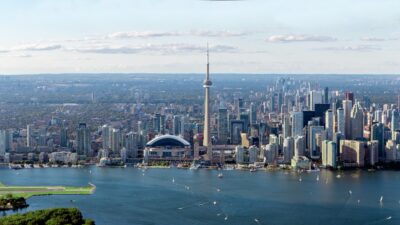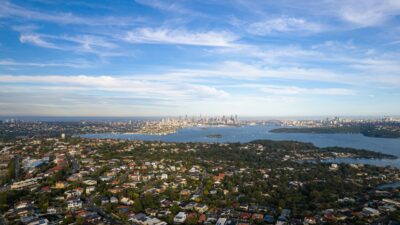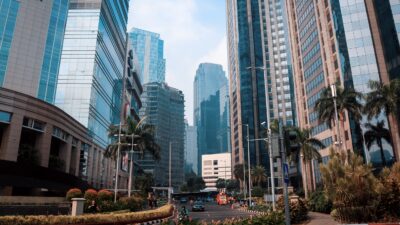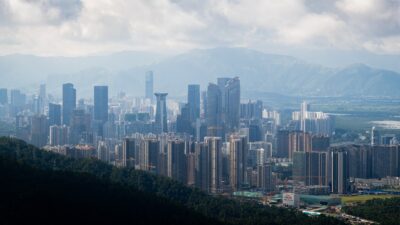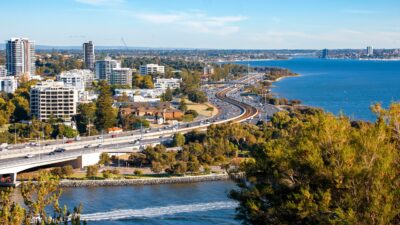Sydney Business Insights and Bo Nielsen

How global cities compete
Today more than half the world’s population lives in cities, and this trend is expected to continue. As 1.5 million people move to cities every week, the country level competition is redefined at the city level. So how do cities compete with each other? We talk to Professor Bo Nielsen to find out.
Show notes and links
The location choice of foreign direct investments: Empirical evidence and methodological challenges
PDF article – Global cities and multinational enterprise location strategy
Professor Bo Nielsen’s profile links
You can subscribe to this podcast on iTunes, Spotify, Soundcloud, Stitcher, Libsyn, YouTube or wherever you get your podcasts. You can follow us online on Flipboard, Twitter, or on sbi.sydney.edu.au.
Sydney Business Insights is a University of Sydney Business School initiative aiming to provide the business community and public, including our students, alumni and partners with a deeper understanding of major issues and trends around the future of business.
Professor Bo Bernhard Nielsen is Professor of Business Strategy at the International Business Discipline at The University of Sydney Business School. His research is at the intersection of strategy, international business, and economic geography with a specific focus on multilevel issues pertaining to strategic collaboration, firm internationalization, and strategic decision-making across borders.
Share
We believe in open and honest access to knowledge. We use a Creative Commons Attribution NoDerivatives licence for our articles and podcasts, so you can republish them for free, online or in print.
Transcript
Sandra Peter Introduction: Today more than half the world's population lives in cities and this trend is expected to continue as 1.5 million people move to cities every week. As cities around the world swell due to rapid urbanisation, more than 80% of global GDP is now generated in these cities. As cities grow, the country level competition is being redefined at the city level. So how cities compete with each other?
Introduction: From the University of Sydney Business School, this is Sydney Business Insights, the podcast that explores the future of business.
Sandra: I am Sandra Peter and today we are talking to Professor Bo Nielsen to find out how cities around the world compete with each other. Bo Nielsen is a professor of business strategy at the University of Sydney Business School. His research focuses on economic geography and is at the intersection of strategy and international business with a specific interest in strategic collaboration and firm internationalisation.
Welcome Bo.
Bo: Thank you.
Sandra: How can we think about cities competing today?
Bo: Well I think it's an interesting question and I think it's important to realise that in the traditional trade and international business literature and understanding, it's been mostly a question about how countries compete compared to advantage between countries or how industries compete across different countries but I think now we have to think about this in a more micro level perspective and we have to think about how cities such as Sydney or Melbourne or even smaller communities, even areas within cities, such as Parramatta or Surry Hills or Manly, how do they compete in global business? And by global business here I mean how do they attract foreign direct investments but also how do they potentially facilitate local firms competitiveness in a national sense.
Sandra: When we talk about cities we often talk about global cities and mega cities but are they the same thing and do any Australian cities fit the characteristics of either global or mega cities?
Bo: So that's a very good question. Traditionally, mega cities were defined by the sheer size of the city in terms of inhabitants and so we defined mega cities as very large cities with more than 10 million people in them. If you look at China, for instance, they have some 10 cities that have more than 10 million inhabitants. Australia has none. India by comparison has some three or four cities that would qualify. But global cities are not mega cities. Global cities are defined by some other characteristics. Specifically, global cities are defined by their global connectiveness and by global connectiveness we think in terms of trade, transportation, infrastructure, people and IT infrastructure.
They're also characterised by having a very cosmopolitan environment which is very attractive to foreign workers, such as ex pats and executives from our countries. And thirdly, typically global cities are characterised as having a wide array of advanced professional service firms which are very conducive to international business. These may include lawyers, accountants, marketing firms, and so forth. And so, if we look at mega cities, these are just very large cities but they're not necessarily well connected. So examples of very large cities are London and Calcutta and other cities in India, for instance, that are not particularly international. And then you have the opposite story which is the global cities and here Sydney would, of course, qualify but also much smaller cities. For instance, Copenhagen, Zurich and even Dublin. These are clearly not very large cities in terms of inhabitants but they're very well connected both in terms of physical and human and organisational interactions.
Sandra: What you describe makes them sound very attractive to businesses. What are firms looking at when moving to global cities?
Bo: They're looking for these three characteristics that I just spoke about and why are they looking for those is perhaps more interesting. While they're looking for these because they help them reduce what we call liability for foreigners. Liability of foreigners is essentially the additional cost of doing business in an international environment. And so, when foreign firms go into new countries, they would face various cost of coordination and of cultural and institutional distance and they have to overcome these costs and be better competitively than domestic firms in order to be competitive.
Now, if you move into a global city and if we talk about Australia it's really only Melbourne and Sydney that qualify as truly global cities, and so if a firm from, say, China or India or Europe or North America enters Australia through either Sydney or Melbourne, they're less likely to encounter some of these high cost of cultural, institutional and coordination differences because Sydney and Melbourne would be on balance more like to, say, New York, London, Tokyo, Hong Kong and so forth.
Sandra: That sounds quite important for things like control and coordination. Do global value chains come into play when we talk about global cities?
Bo: Global value chains are interesting because if you think about global value chains as sort of a division of activities in multinational firms, well within the firm you have its value chain and its subsidiaries which are placed around the world, and there's a coordination issue vis a vie that particular characteristic. However, global value chains in the more broad sense would be all the connecting firms, all the local firms that the multinational firms would work with. And here we think about not only firms that can help them with intermediary goods and supplies, but also these professional service firms that I spoke of before, so accounting firms, consulting firms, marketing firms, and so forth. Most firms would have a need to be connected with these types of firms and they're much more abundant and readily available in global cities. But it's a lot more than just these firms that makes up a global city.
We also have to think about physical infrastructure so you need to have good access to deep sea harbours, you need to have good railroads, good road systems, perhaps international airports, and so forth. And on top of that, I think it's interesting also to think about the IT infrastructure. So, do you have good broadband access? And here's interesting that, if we for instance look at Iceland, Iceland has been very, very successful in attracting IT firms, particularly within the server industry, so Apple has placed some very large server stations in Iceland. While it's very remote geographically, Iceland has certain other advantages. For instance, they have access to relatively cheap green energy through their thermal heating but also they have built two sub ocean cables of broadband IT infrastructure, one to the European continent and one to the UK. And why is it important that they build two of these very expensive DC cables? Well, if you look at what happened to Tasmania recently, they only had one such cable and when it was severed by, I think it was an oil tanker or something, then internet access on the whole of Tasmania has been quite unstable for six months. So for these firms that rely on this kind of technology and IT infrastructure it's of course important that a particular location can provide them with reliable, cheap and steady access to that.
Sandra: Based on what you've said, Sydney seems to be quite well placed - we've got a deep sea harbour, we've got a fairly good IT infrastructure - so who is Sydney competing against and is Sydney attracting the attention of international firms as well as it could?
Bo: Well, I think Sydney is a global city and I think it is attractive to many international firms. We have to think about different types of industries or different types of sectors. So I think it's important to look at specific industries or sectors when we talk about how attractive a particular city is. And so, this also goes for who is Sydney competing against in terms of specific other cities. I think within Australia there's clearly a competition between Sydney and Melbourne, perhaps Brisbane, maybe even Adelaide in certain areas. Internationally, if we think about the financial services industry, then it's really London, New York, Hong Kong, maybe Tokyo, Toronto even, perhaps Seoul. These are strong financial centres on a global scale that Sydney would try to be competing with. But if you're looking at more traditional type of manufacturing or production within, say, higher low-tech industries, well within low-tech industries there isn't that much production around Sydney and whatever there is, it's more likely to be in competition with cities perhaps in eastern Europe, China, India, and maybe even South America.
Sandra: If we drill down, how does micro location choice come into it? So thinking about places like Surry Hills versus places like maybe Parramatta?
Bo: Well, when firms try to decide or managers within firms try to decide where to locate a particular activity of their international business they're really only looking at countries, they're looking at cities. But even within cities the size of Sydney, the size of Shanghai or Beijing, or other large cities, you would be looking for specific locations within these cities. And one of the interesting things that our research has looked at is the difference between CBD and the surrounding areas of large cities. We find, perhaps not surprisingly, that the more manufacturing components there are to these businesses, the less likely they are to be located in and around the CBD area, perhaps because they need access to larger facilities, it's too expensive to locate in the CBD, but they also may need transportation, infrastructure, parking lots and so forth for their employees. But the more removed towards hi-tech and service oriented types of business the more likely these are to be found in very close proximity to CBD. And then of course you can look at specific infrastructural aspects of a location. So the new Sydney metro north-west project and perhaps building an international airport close to Parramatta would certainly be something that will help facilitate these specific areas' attractiveness to certain types of international business.
So, if we turn this around, how would that influence local policy makers? Well, if you were a local policy maker in Sydney or in one of the councils around Sydney, then perhaps you want to look at areas where you can improve your attractiveness to particular types of businesses, be that through IT infrastructure or physical infrastructure or other ways where firms might benefit in terms of reducing their particular cost of location.
Sandra: Is there also cost to these global cities of these firms internationalising?
Bo: There's a potential cost at least to the local environment of that which you're thinking about. Cities need to think very carefully about what happens to a city as it attracts international business. This may cost some unintended consequences. For instance, you can imagine that there might be more pollution, more congestion, traffic issues, but also it might have a cost of a more social nature. It may in fact have implications particularly in the long run for social life and wellbeing of inhabitants in the city beyond what one would expect from domestic firms. It may also influence domestic firms' competitiveness so that it drives out local employment and also local businesses. For instance, when some of the foreign big retail chains enter particular cities like Sydney, they may drive out some of the smaller local players.
And if that's not the intended outcome of attracting foreign direct investments, then cities might think twice about how much they want to attract this particular type of business.
Sandra: We've spoken mostly about how cities attract and retain businesses but do these cities have an impact on how local firms internationalise?
Bo: Yes indeed they do and our current research currently shows that the more urbanisation we see in a country, that is the more we see a trend towards people clustering into larger and more connected cities, the better able are the local firms to internationalise because it provides them with access to the same connectivity and professional services that help them facilitate international expansion. This is particularly evident in the emerging markets where firms in rural areas may have difficulty exporting or investing abroad unless they use the facilities that global cities or urban areas provide them. But it's also very much the case in Australia. You can think of rural Australia and how difficult it is to gain access to international markets overseas unless you try to utilise some of the resources that Sydney, Melbourne or some of the other large cities provide. One might think that with internet and IT in general that physical location near a global city isn't as important for international trade as it used to be but our research actually suggests that it becomes even more important these days to be located, not necessarily in a global city, but in close proximity to global cities or urban areas.
Sandra: Clearly there is more and more competition between cities and amongst cities. How can cities be innovative in attracting foreign direct investment when competing when more established global cities?
Bo: I think is a very good question and certainly this is a question that is being addressed by city officials and perhaps government officials in many countries these days, and it is a good question because some cities have sort of a natural advantage in terms of attracting foreign direct investments. This may be because of their location, it may be because of access to particular natural resources, or just their sheer size in terms of market access. But what can other cities then do that may not have these same advantages?
I think we have some examples of some cities that are very, very innovative in that space. Some cities do it in terms of infrastructure. So we have examples in China, actually in Denmark as well, of cities that are not necessarily located on the ocean even, but they've dug channels, deep sea channels, out into the ocean in order to provide the city with access to a deep sea harbour.
In China this was quite a large project in certain cities where they had to build a 20 kilometre bridge and freeway all the way out to this new harbour to be able to connect it to the existing infrastructure of the city. But there are other things you can do. The example of Iceland where you build infrastructure in terms of IT that attract certain types of businesses. But I think there is other examples of cities that are trying to build more cultural attractiveness into their cities. Copenhagen, for instance, is trying very hard to become a conference centre in Europe so they're building conference capabilities with large scale hotels and conference facilities. There are small communities outside Copenhagen main city that are trying to be innovative in attracting foreign workers by switching all of their public systems into English. So one of the biggest problems can be that you can't necessarily as a foreigner connect to the authorities in your local community unless you speak the local language. So they've converted all of their information on their website and all of the employees in the local community government offices now speak English and are required to provide information in English and this is tremendously valuable to many foreign workers. But that isn't enough. On top of that, they've now added Chinese.
So now all of this information is also provided in several Chinese dialects and this has already increased the number of investments from China into this particular region of Copenhagen. So, you can see how cities can provide incentives for particular firms for particular countries or industries to locate in their specific area by being a little bit innovative and thinking outside the box.
Sandra: It sounds like a fascinating area for further research. What's next for you?
Bo: Well, so this is what is next for me: one of the things we're looking at in several research programs I'm involved in is to try to focus more on these micro level drivers of attractiveness of particular locations to foreign direct investments. We want to understand what makes a particular area and location within a city or around a city particularly attractive or not attractive to particular types of firms from abroad. We also want to turn the equation around a little bit and think about how that particular local community might either benefit or not in these particular types of investments. What happens to the local community? What happens to local businesses? What happens to congestion of traffic? What happens to infrastructure? What happens to labour wages, labour in general, in these areas?
There's not a lot of research that has looked into these particular issues with focus on micro location choice and, along that agenda, you could say we are starting a new research group which is focusing specifically on global cities and global value chains. And the idea is to bring together scholars from all over the world and from very diverse areas of research to focus on these areas because, as you can see already, this has to do with transportation, infrastructure, economics, business, sociology, cultural status, even perhaps architecture in other areas. So we have to get all of these disciplines to think about how global cities and global value chains may change the way that we think about competition and business.
Sandra: Bo, thank you very much for talking to us today.
Bo: Thank you very much, Sandra.
Outro: You've been listening to Sydney Business Insights, the University of Sydney Business School podcast about the future of business. You can subscribe to our podcasts on iTunes, SoundCloud or wherever you get your podcasts and you can visit us at sbi.sydney.edu.au and hear our entire podcast archive, read articles and watch video content that explore the future of business.
Close transcript

